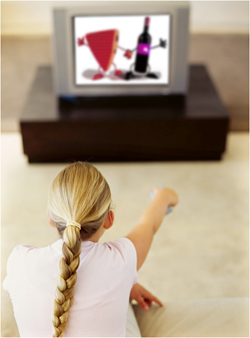
Seeing and liking alcohol advertising on television among underage youths was associated with the onset of drinking, binge drinking and hazardous drinking, according to a new study by researchers at the Norris Cotton Cancer Center (NCCC) and Children’s Hospital at Dartmouth-Hitchcock (CHaD) published online by JAMA Pediatrics.
CHaD pediatrician and associate professor of pediatrics at the Geisel School of Medicine at Dartmouth Susanne E. Tanski, MD, MPH and her coauthors examined the reach of television advertising and its effect on drinking in young people. In 2011 and 2013, they conducted telephone- and web-based surveys with 2,541 adolescents and young adults between the ages of 15 and 23 years at baseline, with 1,596 completing a follow-up survey. The surveys examined recall of more than 300 television advertising images for top beer and distilled spirits brands that aired nationally in 2010-11. The authors derived an alcohol receptivity score based on having seen the ad, liking it and correctly identifying the brand.
“The alcohol industry claims that their advertising self-regulation program protects underage youths from seeing their ads,” said Tanski. “Our study indicates that it does not.” Participants who were underage were only slightly less likely than legal-drinking-age participants to have seen alcohol ads (the average percentage of ads seen were 23.4 percent, 22.7 percent and 25.6 percent, respectively, for young people ages 15-17, 18-20 and 21-23 years of age).
Alcohol is the most common drug used by young people. In 2013, 66.2 percent of U.S. high school students reported trying alcohol, 34.9 percent reported alcohol use in the past 30 days and 20.8 percent reported recent binge drinking. In the U.S. alone, producers of alcohol spend billions of dollars annually marketing their products. And, unlike cigarettes, which voluntarily ended television advertising in 1969, alcohol is actively marketed on television, according to the study background.
Survey results indicate that higher alcohol receptivity score among underage participants predicted the onset of drinking, binge drinking and hazardous drinking in the future. The transition to binge drinking (participants were asked how often they have six or more drinks on one occasion) and hazardous drinking (which was defined as meeting or exceeding a threshold score for frequency and quantity of alcohol use) happened for 29 percent and 18 percent of young people ages 15 to 17 years, respectively, and for 29 percent and 19 percent of young people ages 18 to 20 years, respectively.
“Alcohol companies claim their advertising does not affect underage drinking – that instead it is parents and friends that are the culprits,” said James D. Sargent, MD, senior author on the study and a CHaD pediatrician, the Scott M. and Lisa G. Stuart Professor of Pediatric Oncology at Geisel, and co-director of the NCCC Cancer Control Program. “This study suggests otherwise – that underage youths are exposed to and engaged by alcohol marketing and this prompts initiation of drinking as well as transitions from trying to hazardous drinking.”
“Our study found that familiarity with and response to images of television alcohol marketing was associated with the subsequent onset of drinking across a range of outcomes of varying severity among adolescents and young adults, adding to studies suggesting that alcohol advertising is one cause of youth drinking,” the authors conclude. “Current self-regulatory standards for televised alcohol advertising appear to inadequately protect underage youth from exposure to televised alcohol advertising and its probable effect on behavior.”
The above is a verbetum copy of the news release by Darthmouth-Hitchcock. For the abstract of the article, please click here>>
EUCAM would like to point out that the findings are in line with the greater body of scientific articles on the effects of exposure to alcohol marketing. The findings indicate a need for strenghtening alcohol marketing regulations, in order to protect children from exposure to alcohol marketing.
EUCAM was positively surprised to see the above article was picked up by many other websites:
-The Huffington Post: More Evidence That Alcohol Ads Are Linked To Teen Binge Drinking
-News Every Day: TV Alcohol Ads Increase Risk of Binge Drinking in Teens, Study Finds
-The Daily Times: Alcohol ads on TV tied to youth drinking risk
-Time: Here’s What Alcohol Advertising Does To Kids
-Media Post: Alcohol Ads Linked To Underage Drinking
-Science Daily: Alcohol ads on TV associated with drinking behavior in young people
-Medical News Today: Exposure to alcohol ads on TV linked with underage drinking
-H-Insurance: Exposure to alcohol ads on TV linked with underage drinking
-Medical Daily: Underage Drinking May Stem From Alcohol Ads, Despite Older Intended Audience
-University Herald: Alcohol Ads on TV Tied to Drinking Behavior in Young People

